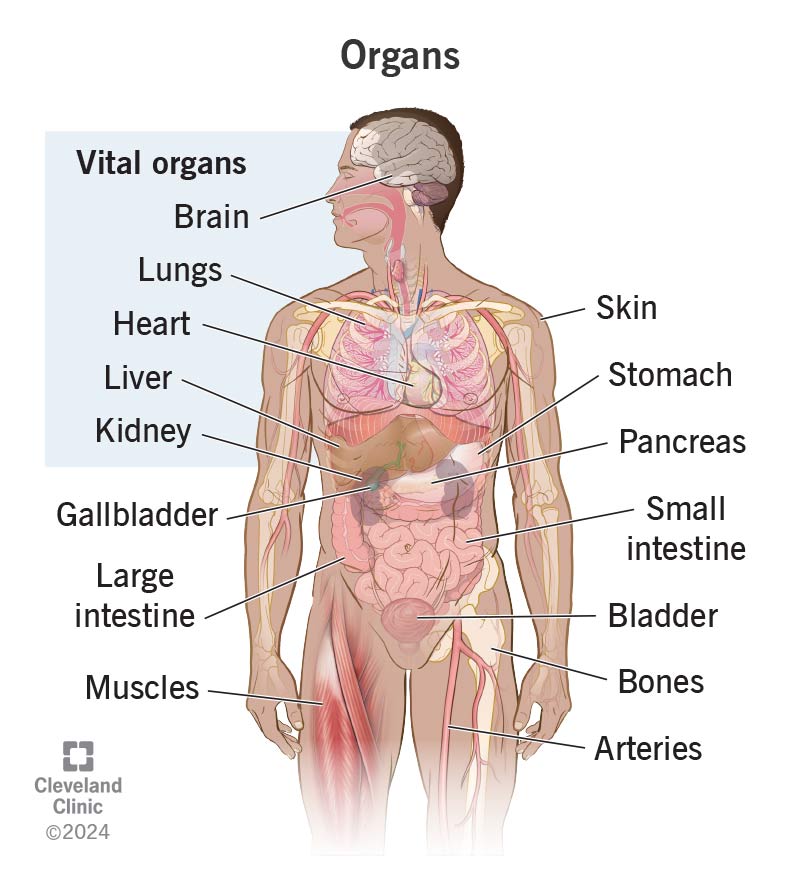Your organs are what make you who you are, and they run every body process you need to live. They aren’t just parts inside you, like your liver or lungs. They also include parts on the outside of your body, like your eyes and mouth. But whether or not you can see them or realize they’re hard at work, they’re a key part of every day of your life.
Advertisement
Cleveland Clinic is a non-profit academic medical center. Advertising on our site helps support our mission. We do not endorse non-Cleveland Clinic products or services. Policy

Organs are specialized structures in your body that handle specific jobs. Some of the best-known organs are your heart, brain or liver. But many other structures count as organs, too. That includes some you might not think of, like your skin.
Advertisement
Cleveland Clinic is a non-profit academic medical center. Advertising on our site helps support our mission. We do not endorse non-Cleveland Clinic products or services. Policy
Each of your cells is like an individual worker doing a specific job. Tissues are groups of related cells teamed up in the same place. Organs consist of many tissues that work together cooperatively to accomplish a bigger job.
Organs are part of bigger systems that handle interconnected jobs. And some organs can be part of more than one system. Some examples of organ systems and the organs that are part of them include:
Advertisement
Organs can be single structures like your heart. But they can also be a group of the same type of structure. For example, your bones are technically an organ, but so is the bone marrow inside most of your bones.
You might get a different answer depending on who you ask. Before 2016, the number of organs was widely recognized as 78. But researchers continue to expand modern medicine’s understanding of how the body works. That’s why, if you ask experts today how many organs you have, the answer can range from 78 to 80.
In particular, two discoveries explained in research papers from 2016 and 2018 now have experts split on the true number. The two organs that are gaining acceptance but still have some controversy behind them are:
There’s still a lot of ongoing research into how these organs work and what they do. And advances in technology and medical science may lead to further discoveries.
Vital organs are organs that you need to survive. Your body can’t function without them. Some key examples of vital organs include your:
You have several organs that are centered inside your body, while others are clearly to one side.
Some examples of centered organs in your body include your:
Some examples of left-side organs include your:
Examples of right-side organs include your:
And you have several paired organs, with one on each side of your body. They include your:
You can survive without several organs. They include your:
You can also survive with just one of several paired organs, like your lungs or kidneys.
While you can’t survive without your heart or at least one kidney, there are artificial versions that can do their jobs. Artificial hearts can be long-term replacements for damaged or diseased hearts. And dialysis can be a long-term substitute (but not a permanent replacement) for your kidneys.
Advertisement
Accessory organs are organs that contribute to a body system, but they might not necessarily be a clear part of it. One example is your gallbladder, which contributes to your digestive system. Breasts are another example. They can contribute to your reproductive system during breastfeeding.
But being an accessory organ doesn’t mean that organ isn’t important. Your liver is an accessory organ to your digestive system, but you also can’t live without it.
The largest body organ you have is your skin. It makes up about 15% of your total body weight. But for just your internal organs, the largest is your liver.
Organs aren’t just something you have inside you. There are plenty of parts on the outside of your body, like your eyes and other facial features, that are organs, too. It can be easy to take them for granted, especially when everything’s working as it should. But if you’re sick and you have an organ issue, it can be hard to think about much else. If you have questions about taking care of your organ health, talk to a healthcare provider. They can offer guidance on how to best take care of your organs and your health overall.
Advertisement
Cleveland Clinic’s primary care providers offer lifelong medical care. From sinus infections and high blood pressure to preventive screening, we’re here for you.

Last reviewed on 12/05/2024.
Learn more about the Health Library and our editorial process.